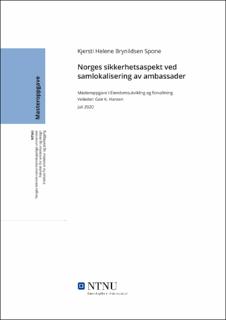| dc.contributor.advisor | Hansen, Geir K. | |
| dc.contributor.author | Spone, Kjersti Helene Brynildsen | |
| dc.date.accessioned | 2021-09-13T16:24:21Z | |
| dc.date.available | 2021-09-13T16:24:21Z | |
| dc.date.issued | 2020 | |
| dc.identifier | no.ntnu:inspera:61009049:45573880 | |
| dc.identifier.uri | https://hdl.handle.net/11250/2776163 | |
| dc.description.abstract | Samlokaliserte ambassadebygg er komplekse bygg og en noe usedvanlig bygningstypologi. Utenriksdepartementet har det overordnede ansvaret for byggene. Utenrikstjenestenes arbeid består blant annet av å ivareta og fremme Norges interesser overfor utlandet, gi norske statsborgere råd og hjelp ovenfor utenlandske myndigheter, personer eller institusjoner samt å gi bistand til norske statsborgere i utlandet. Utenriksstasjonene har hovedansvaret for å ivareta disse oppgavene i utlandet, særlig gjelder dette å gi bistand til norske statsborgere. Ved samlokalisering er det mange forhold det må tas hensyn til, et av de mest sentrale temaene er sikkerhet.
Formålet med denne oppgaven er å kartlegge hvordan sikkerhetsaspektet blir ivaretatt ved samlokalisering av ambassadebygg. Dette er basert på den politiske bestemmelsen om at nordiske ambassadebygg skal samlokaliseres når det er mulig. Dette ble vedtatt på bakgrunn av Stoltenberg rapporten i 2009. Likevel er det foretatt svært få evalueringer av samlokaliseringsprosjektene og ulike aspekter knyttet til ambassadene. Et av de sentrale punktene i Stoltenberg rapporten var at det er kostbart å opprette og drifte utenriksstasjoner. Dagens krav til sikkerhetsaspektet har ført til kostnadsøkninger flere steder, men ved samlokalisering ble det spekulert i om kostnadene ville kunne fordeles bedre og senkes. På bakgrunn av dette er oppgavens problemstilling følgende: Hvordan blir Norges sikkerhetsaspektet ivaretatt ved samlokalisering av de nordiske ambassadene?
Oppgavens teoretiske rammeverk er tredelt:
1. Sentral terminologi samt lovverk og annet regelverk knyttet til sikkerhet.
2. Teori og litteratur knyttet til sikkerhet og sikring av bygg.
3. Teori knyttet til planlegging og organisering av byggeprosjekter.
Forskningsdesignet bygger på kvalitative metoder som inkluderer dybdeintervjuer og casestudier. Masteroppgaven er gjennomført i samarbeid med Utenriksdepartementet og har tatt for seg tre samlokaliserte ambassader.
Masteroppgaven konkluderer med at det norske sikkerhetsaspektet ved samlokaliserte ambassadebygg blir godt ivaretatt med bakgrunn i Samarbeidsavtalen. Denne avtalen sikrer at det strengeste kravet, innenfor de ulike sikringsområdene, til en hver tid skal være gjeldende. Det har også blitt avdekket ulike sikkerhetsmessige gevinster ved samlokalisering. Dog har det blitt avdekket at det er flere aspekter ved planleggingsprosessen som har behov for vesentlig forbedring. Dette omfatter blant annet prosjektorganisering og struktur i byggeprosessen. | |
| dc.description.abstract | Co-located embassy buildings are a complex building with a somewhat unusual building typology. The Norwegian Ministry of Foreign Affairs has the overall responsibility for the Norwegian embassies. The essential task of the Foreign Service consists of maintaining and promoting Norway´s international interests, giving Norwegian citizens advice and assistance in dealing with foreign authorities, persons or institutions and aiding Norwegian nationals abroad. The Foreign offices main responsibility is to take care of these tasks abroad, especially aiding Norwegian citizens. Co-location comes with a lot of aspects that need to be taken in to account, one of the most important matters is security.
The purpose of this assignment is to identify how the Norwegian security aspect is ensured when the Nordic embassies co-locate. The co-location of the Nordic embassies was decided through a political decision and compose some of the background for this assignment. The political decision is grounded in the famous Stoltenberg report from 2009. Even though this was decided many years ago, there has still not been conducted any official evaluations of the co-location projects and important aspects. One of the central remarks in the Stoltenberg report claims that it is very expensive to establish and run the Foreign offices. Today’s security demands have also contributed to a rise in the total cost in several locations, but with co-location it was anticipated that it would be possible to distribute the costs more evenly and possible lower them with a considerable amount. The assignment, therefore seeks to answer the following problem statement: With a shared location between Nordic embassies, how can Norway safeguard all security interests?
The theoretical framework for this thesis is three-folded:
1. Essential terminology as well as laws and regulations associated with security.
2. Theory and literature linked to safety and security in buildings.
3. Theory linked to planning and organizing of construction projects.
The research design is based on qualitative methods which include in-dept interviews and case studies. The master´s thesis is conducted in collaboration with The Norwegian Ministry of Foreign Affairs and has assessed three co-located Nordic embassies.
The conclusion of this master´s thesis is that the Norwegian security aspect in co-located embassies is well considered and ensured through the Cooperation agreement. This agreement secures the highest security requirement within the different areas of security. There have also been discovered additional security advantages as a result of the co-location. However, it has been revealed that several aspects of the planning process need significant improvement. This includes the project organization and structure in the construction process. | |
| dc.language | | |
| dc.publisher | NTNU | |
| dc.title | Norges sikkerhetsaspekt ved
samlokalisering av ambassader | |
| dc.type | Master thesis | |
